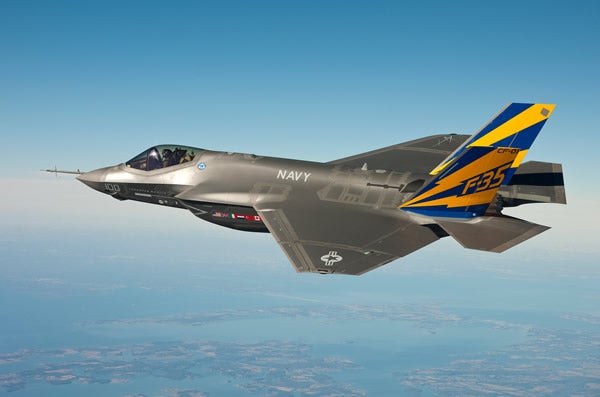Fox News’ Allison Barrie lauded the F-35 program recently, saying:
Last Friday, the U.S. Marine Corps’ VMFAT-501 training squadron in Florida’s Eglin AFB launched its first F-35B eight-ship, flew a mission, hot-pit refueled and went back up again. This mission is the latest in a series of promising steps forward for the F-35.
The F-35 Joint Strike Fighter, the stealth fighter of the future for the U.S. and many of its allies, has achieved many developmental milestones recently. While many decry the new fighter as unnecessary and too expensive, the plane offers unprecedented capabilities for the U.S. military both in terms of warfighting and cost-effective operations.
The F-35B variant Barrie discussed has short takeoff and landing capabilities, meaning it can take off on amphibious ships, smaller aircraft carriers, or short runways. This will enable the U.S. Marine Corps and the U.K. Royal Air Force and Navy to replace their aging fleets of Harrier jets.
The F-35 represents more than merely a one-to-one replacement though, as it is more capable than legacy craft in a number of ways. While Barrie primarily focuses on the significant advances in stealth technology, the F-35 also incorporates electronic warfare capabilities not found on its predecessors, a visual array that gives pilots a 360-degree field of vision and advances in speed and weapons systems. As a result, the three F-35 variants—including also the conventional landing and takeoff “A” for the U.S. Air Force and allies, and the carrier variant “C” for the U.S. Navy—will also replace F-16s, F/A-18s, EA-6Bs, F-111s, and A-10s.
Another way the F-35 will be a game-changing asset to the U.S. military lies in its advanced communications systems. The plane is able to communicate across the allied partners’ fighters, transfer information to logistics vehicles, and operate with the Aegis weapons system to create a command and control platform. In these ways, the F-35 as a fleet will create a network that serves operations beyond its own combat mission.
The F-35 will be cost-effective and sustainable in the long run as well as effective in performing its missions. This is also due to the joint nature of the program. As Second Line of Defense’s Robbin Laird explains, the F-35 takes advantage of a “global supply chain.” Thirty percent of the plane is built by the prime contractor and much of the other 70 percent is spread across international suppliers. This, combined with the shared cost burden across the partner nations, means production of the F-35 will be more sustainable.
The cooperative aspect of the F-35’s sustainment will in turn create a capability advantage. As Laird puts it, “[B]ecause the planes are the same, and there is 80% commonality across all three variants, an Australian supply hub can support allies throughout the region including the United States.”
Hypothetically any one F-35 could land in any one partner nation to receive maintenance or refueling. For the U.S., this will create less need to transport parts and labor across the globe to keep its fighters in working order.
The F-35 Joint Strike Fighter has greatly emphasized the “joint” part of its name. The program is taking advantage of cost sharing, allies’ trust and relationships, and enhanced communication with other military platforms to integrate it in a new and unique way. The U.S. and its allies should continue their commitment to the program to ensure that it matures responsibly and successfully.
